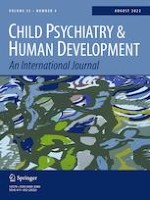08-05-2021 | Original Article
Examining the Process of Implementing a Three-Step Mental Health and Wellbeing System of Care for Children and Adolescents Across Multiple Community Settings
Gepubliceerd in: Child Psychiatry & Human Development | Uitgave 4/2022
Log in om toegang te krijgenAbstract
Mental health problems affect large numbers of young people. Integrated systems are required that can be applied in diverse settings to reach youth ‘where they are’. We evaluated the process of implementing a three-step youth mental health and wellbeing system in diverse community settings according to three implementation outcomes: feasibility, penetration and acceptability. The study describes 49 applications of the ‘Life-Fit-Learning system’ designed to assess the mental health and wellbeing of youth (Assess step), provide feedback on assessment results (Reflect step), and connect them to resources and services proportionate to their needs (Connect step). Within a participatory research approach, 3798 administrations were conducted with youth between 9 and 18 years and 90 administrations were conducted with adults. Implementation was based on the four phases of the Quality Implementation Framework and was staged to integrate stakeholder and consumer feedback and experience gained from focus groups and two pilot phases before full implementation. Feasibility ratings of successful implementation ranged from 86.7 to 96.4% across applications and settings. High penetration rates were achieved. The Life-Fit-Learning system successfully reached 91.9% to 96% of youth with the Assess and Reflect steps and low intensity Connect step resources. Of those, 14.7% to 23% were identified at-risk for mental health problems and 93% to 97% of those at-risk youth additionally received Connect step co-delivered group-based programs (moderate intensity care) and/or individual treatment (high intensity care). Youth and parents reported high satisfaction across all steps and delivery modes. With strong collaboration, an integrated model of care can be delivered feasibly, effectively and satisfactorily to reach large numbers of young people across settings.
